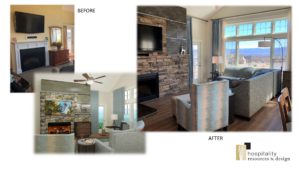“Property improvement and interior design planning for resorts” was the topic of a recent Timeshare Board Members Association Conversations Series Webinar.



Pictured above from left to right: Cam Abascal, Angel Delgado, and Jeffrey Weinland
Cam Abascal of Hospitality Resources & Design, Angel Delgado of Innovative Hospitality Partners, and Jeffrey Weinland of the University of Central Florida’s Rosen College of Hospitality Management joined Shep Altshuler, TBMA president, for this discussion. Following are edited highlights:
Planning for the future
While the pandemic created new and unique challenges for timeshare resorts, basic strategies for maintaining a safe and relevant property should always be part of the planning process.
Weinland: The most important concept is planning for the future, so that resorts continue to be sustainable organizations long into the future. One of the best ways of doing that is to look at what’s going on both inside and outside your organization, and plan for what you are going to do to improve your property to make sure that it stays relevant.
Delgado: We want to keep our resorts modern. We have competition with new resorts and new properties, and it’s important to offer something that the consumer still wants.
Keeping the property structurally sound is very important, because now we’re talking about safety. So, part of the whole process is to make sure the property is up to speed with respect to codes and regulations.
Another thing we want to do, for the survival of the resort, is to provide amenities that attract newer generations of users. If nothing changes physically on the property over the years, you lose some of that competitive edge compared to the amenities that other properties offer.
Occasionally, something pops up that you haven’t planned for and have to address. That’s the reality. It can be anything, such as COVID-19, and new laws and regulations that may require upgrades to older systems. Many legacy resorts see this with Americans with Disabilities Act compliance.
I believe in collecting feedback from owners and guests. As property managers, we see some of the things that are required, but ask the consumers what they want. This will help you with planning for the future, because listening to the consumers will point you in the right direction.
Property improvements roadmap
The critical steps toward creating a long-term improvement plan for your property include a reserve study, prioritizing projects, obtaining approvals, submitting requests for proposals, and more. Delgado discussed those steps in detail.
Delgado: You definitely need a reserve plan. This will be your roadmap for the next several years to define what needs to be done to your property, how long the effort will last, and what needs to be replaced.
Once you complete the reserve study, senior management at the resort and the resort-management company prioritize those things and review the costs. Once you have those things in place, you go to the board of directors with a recommendation. After the plan is approved, the property will send out requests for proposals (RFPs), because we have now defined what we need to accomplish. We invite three different bidders and explain the scope of the project—what needs to be done—and we ask them to submit bids for review. Once we’ve chosen the contractor, work commences on the items specified in the RFP and follows the accompanying timeline.
For smaller projects that are not complex or time-consuming, oversight by the resort manager or general manager can suffice. However, when we do large construction projects, we should work with an implementation specialist such as a general contractor, who has the proper license and insurance. Always request references. Remember, the lowest-price bid does not mean you’ll get the best deal; the quality and value of the work, or the product you’re purchasing, determines that outcome.
Once you’ve chosen the general contractor in charge of the project, involve a licensed and insured project manager. That individual should be independent of the general contractor. He should provide oversight, and make sure that the general contractor does everything right, including having enough insurance and securing approval for any change orders.
When the project is completed, ensure that you have the proper documentation, such as operation manuals and blueprints.
Design-team collaboration
So, how does a property-management company collaborate with the interior-design team on a property improvement plan (PIP)? And what other factors should come into play?
Abascal: As a licensed interior-design firm, we often work in collaboration with the property-management company and the contractor. The key to all of this is communication, to achieve a successful outcome.
If 2020 taught us anything, it was that we learned through implementation how to bend and stretch. When we were faced with a new challenge, we asked everybody for their input—right down to engineers and housekeepers, because they are the boots on the ground. When you’re faced with some of the conditions we were in 2020, we found that by collaborating with everybody, not just the general managers, but everyone on the team, we received some great ideas, and we conquered some pretty tough challenges.
What’s very important right now, when you’re moving forward with a PIP, are two major things. One, we have to create and implement designs that fit with the owner demographic as well what the new buyer is looking for. That demographic may be different, so we try to counsel everybody involved so that we get the best outcome. On top of that, we make sure that we keep current safety protocols front and center for the property.
What to expect from your design team
Abascal: At this point, we’ll know what’s to be included because the budgets have been discussed. You should expect professional, digital presentations from your design firm; these are CAD drawings, whether they’re generated from drawings that the property has, or we go to the units themselves to take measurements. We want to make sure that the scale of the furniture that we’re installing is appropriate and that it functions properly.
Bedspreads have pretty much gone by the wayside. Instead, a top sheet as part of a triple-sheet system can provide color, it’s lightweight for the housekeeping team, it’s easy to wash on a regular basis, and it gives guests peace of mind, knowing that they have fresh, clean linens.
Another thing you might expect from your design team are digital renderings which show what the new elements will actually look like. We’re doing a lot of things virtually, so we can walk through a design with someone via the computer and not have be there physically.

Pictured above: Resort before and after images along with a digital rendering. Courtesy of Hospitality Resources & Design
Whether it’s face-to-face meetings via Zoom, PDFs, presentations, PowerPoints, slides, CAD drawings, and everything else, it’s a living, breathing project. Adjustments have to be made, so communication is utmost, to make sure that everybody stays on the same page and on the same timeframe for getting things completed.
Plan and design for change
Whether your property needs to be refreshed or you have critical life-safety project needs, look at what is important to longtime and new owners alike.
Weinland: Memories of the resort are created and those tend to be lifelong memories. Design is a big part of that for timeshare owners, whether for the nostalgia value or because of their positive feelings about their timeshare vacations.
Delgado: COVID-19 threw a wrench into everything. Suddenly all the things that we thought perhaps were important got pushed back or moved to another year unless they were life-safety issues. Consumer needs changed, and as a timeshare, you have to change to meet those needs. All of the things that had to be done inside rooms, at the front desk, throughout your property, the amenities, became a whole different ballgame. So, in 2021, we hopefully get back to some of the things that we were trying to do before COVID-19.
Abascal: Remember, on larger projects, things are decided generally one to two years out, or more, so those funds have been set aside and products have been ordered. Shutdowns during COVID-19 made installation and implementation a little bit easier because there was less guest inconvenience if the property wasn’t running at a high occupancy. We tried to make sure that we, through really good communication, worked with the property manager to make sure that the installations went smoothly.
Weinland: It’s the old adage that if you fail to plan, you’re planning to fail. You need to have a step-by-step plan and an understanding of why the plan is important. As soon as you start to leave the comfort zone of the management team that you have in place, you need to go out and hire the right professionals to do the job.
To continue the conversation, contact:
Cam Abascal, senior designer, Hospitality Resources & Design, cam@hrdorlando.com
Angel Delgado, chief financial officer, Innovative Hospitality Partners, angel@innovativehospitalitypartners.com
Jeffrey T Weinland Ph.D., University of Central Florida Rosen College of Hospitality Management, Jeffrey.Weinland@UCF.edu
Shep Altshuler, president, Timeshare Board Members Association, staff@tbmassoc.org
Visit: www.tbmassoc.org
